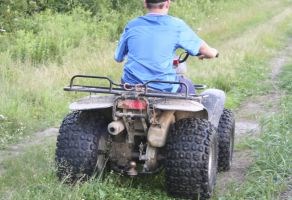Over the past few years, there has been an increase in the number of people injured or killed while riding ATVs, according to a Manitoulin OPP news release.
In 2007, the OPP Northeast Region investigated seven fatal ATV collisions. Twenty-six people were killed while riding in OPP jurisdictions across Ontario, seven of which were under 25.
The OPP is informing the public that off-road vehicles now have access to the shoulder and paved portions of certain provincial highways.
Regulations came into effect in 2003, and applies exclusively to one category of off-road vehicles. An off-road vehicle is categorized as:
- having four wheels, of which the tires are all in contact with the ground;
- having steering handlebars;
- having a seat that is designed to be straddled by the driver;
- meeting requirements of the federal Motor Vehicle Safety Act (MVSA) and American National Standards Institute (ANSI) standards.
This regulation does not apply to other types of off-road vehicles, such as mini-bikes, dirt bikes and motocross bikes.
The following are legislative requirements for operating an ATV in Ontario and an outline of safe riding practices:
- Riders must wear an approved motorcycle helmet;
- Always carry ownership, insurance and driver’s licence when riding on roads;
- Obey speed limits. A maximum of 20 km/h is required on roads where the speed limit is 50 km/h or less and a maximum 50 km/h is required where the speed limit is more than 50 km/h;
- When travelling on roads, drive on the shoulder in the same direction of traffic;
- Drivers must be at least 12 years old to operate an ATV off-road unless under close adult supervision;
- To drive an ATV on roads, the operator must be at least 16 years old and have a valid G2/M2 licence;
- Young riders lack the physical strength, experience and cognitive skills to operate an ATV safely. Know their abilities before letting them ride;
- Off-road vehicles must be registered and have a valid permit. There are some exemptions in place, such as for farmers, trappers and public utility workers;
- It is against the law to drive an off-road vehicle when impaired by alcohol or drugs;
- Off-road vehicles must have specific equipment, including working headlights, tail lights, brakes and reflectors, as well as low-pressure bearing tires;
- Always wear proper eye protection. This does not include sunglasses;
- Always wear proper clothing, such as boots, gloves, pants and a long-sleeved shirt or jacket;
- Be prepared. Always carry a map, compass or GPS unit, and a first aid kit Be sure to know how to use these items;
- Carrying an axe, a rope, waterproof matches and high-energy snacks is a good idea.
As of July 2003, municipalities were given the authority to determine if off-road vehicles should be allowed to access to highways under their authority, stated the news release. Municipalities must put a bylaw in place for off-road vehicles to be allowed access to the area's highways. They can determine which highways and where, and the time of day and seasons when off-road vehicles are allowed access.
Municipalities can also set speed limits lower than those set out in the regulation. If a bylaw does not exist, off-road vehicles are not allowed to access the municipality’s roads. Contact the city office for off-road vehicle bylaws.
For more information about on-road and off-road ATV legislation, visit www.e-laws.gov.on.ca.



